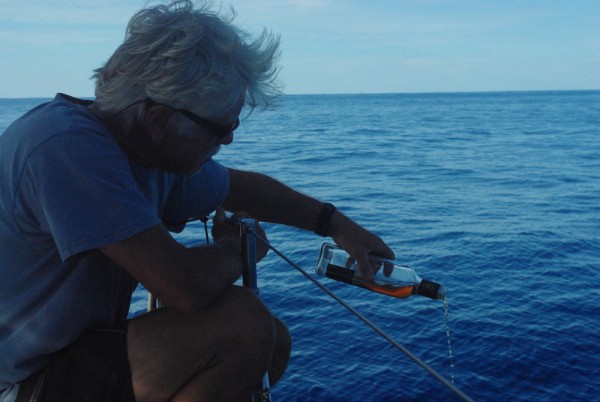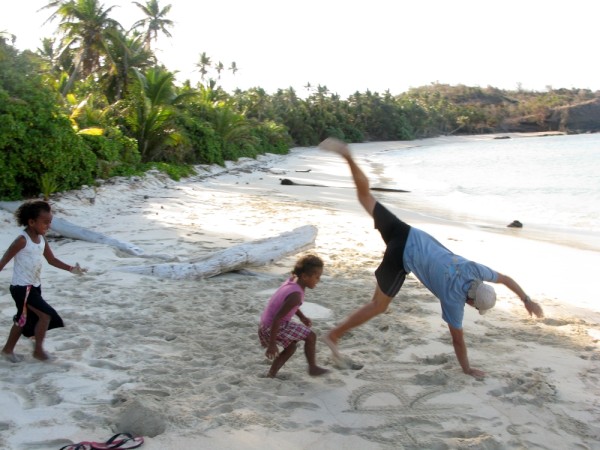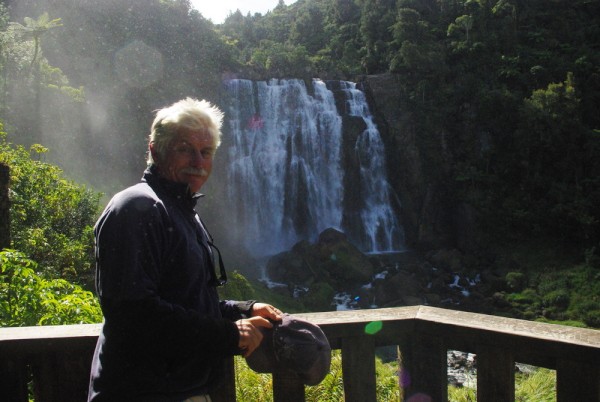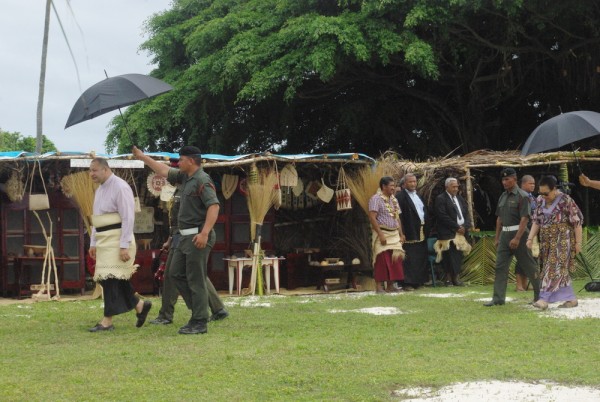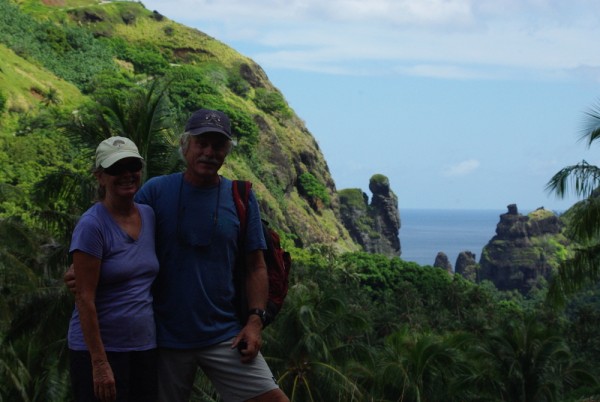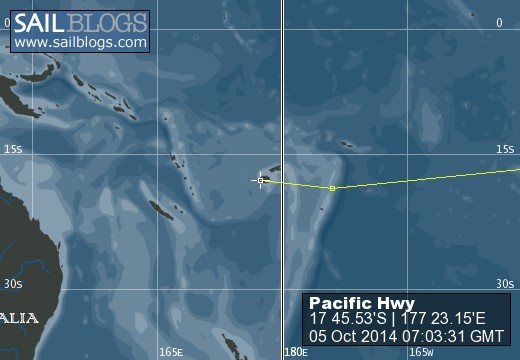
Pacific Hwy
10 January 2017 | Lechinioch
15 March 2016 | Sydney Australia
23 April 2015 | Majuro, Marshall Islands
08 November 2014 | Tarawa, Kiribati, Middle of the Pacific Ocean
27 October 2014 | Lautoka, Fiji
04 October 2014 | Fiji
19 February 2014
20 August 2013
28 July 2013
20 May 2013 | French Polynesia
19 May 2013 | Makemo
19 May 2013
11 May 2013
12 April 2013
11 April 2013
10 April 2013 | Latitude 00.00
07 March 2013 | Banderas Bay
02 February 2013 | Nuevo Vallarta
21 January 2013 | Mexican Riviera
09 January 2013 | Chamela Bay
Giving the King His Day
20 August 2013
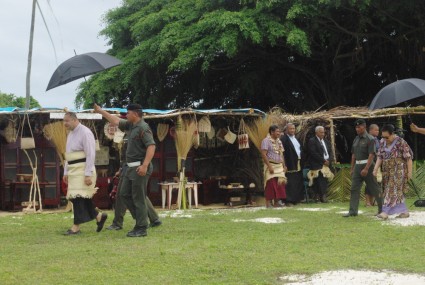
We left Suwarrow, a small isolated atoll in the Cook Islands inhabited only by two park rangers, for American Samoa. American Samoa has a bad reputation (much like St. Thomas in the VI) and gets almost no tourism. But it is a US Territory (also like St. Thomas) which means that it has a US postal zip code so it is very easy (and inexpensive) to ship items from the US using good ole Priority Mail service. So we put American Samoa on our itinerary and ordered a bunch of boat stuff, replacement prescription eyeglasses and sunglasses, and a tiny but crucial microchip for our chart plotter with charts for New Zealand. God Bless the US Postal Service, General Delivery! We also got to shop at Cost U Less (our favorite place to shop on St. Thomas) and stock up on familiar US items like whole bean coffee, Parmesan cheese, feta, jalapeno jack, canned peaches, canned beans, chili powder, and canned tomatoes. While we were there, we attended the once-a-month Friday night food fair and sampled delicious chicken rotis ($2) and California rolls ($1). All in all it was a very nice stopover in spite of the Starfish tuna cannery which makes the anchorage smell at times like burnt sneakers. We'd like to add that the Samoans rank among the friendliest people on earth, speak English with an American accent even though their native tongue is Samoan, and have a beautiful, pristine island that includes a US National Park.
From American Samoa we sailed south to the Kingdom of Tonga. When Captain Cook arrived in Tonga in 1777 he and his crew were greeted with a lavish feast and island entertainment. This led Cook to name the group of islands the "Friendly Islands." In fact, the feast had been planned by the island chiefs in order to get all the men in one spot and murder them so that the chiefs could loot the two ships. But the chiefs got into a dispute among themselves about the best time to do the deed and so the raid was called off.
There are probably more churches per capita in the South Pacific islands than anywhere else on earth. Tonga is so devout that they re-directed the international dateline to dogleg around Tonga so that they could be first people on the planet to go to church on Sunday morning. We left American Samoa on Sunday morning, sailed for 24 hours, and arrived on Tuesday morning at a small, remote island affectionately know as "New Potatoes" by language impaired cruisers. What happened to Monday? It's one thing to lose an hour to daylight savings time, but to lose a whole day just for the privilege of sleeping through a sermon a day ahead of the Samoans! That's taking island rivalry a bit far! When we realized our overnight sail took two days according to the calendar, we decided we needed a nap. But fellow cruisers stopped by the boat with urgent news that we must immediately go ashore and clear customs because the next day the King was coming and there would be a big festival in his honor and all offices would be closed!
What luck! The next morning the supply boat came in with the King and his entourage which included his wife, Talking Chiefs (the only people allowed to speak directly to the King) and a brass band. The small population of New Potatoes (an island of subsistence living without the benefit of electricity or internet) had decorated the two mile stretch of road to main town with palm fronds. There was an Agricultural Fair with each community displaying it's fruits, vegetables, arts and crafts (hand woven mats and baskets) and locally caught fish and lobster. The band played. The Talking Chiefs talked. Then the men performed a traditional warrior-like dance and then the young girls performed the hula-like eligible-bachlorette dance to lovely accapella singing. In Tonga the women wear longs skirts and blouses that cover the shoulders, even when swimming! But the costumes of the young dancers was a strapless wrap-around tapa cloth cinched a the waist and the girls applied coconut oil to their arms and shoulders so that they were gleaming (big time seduction I would assume). After their very demure and graceful dance, villagers (both men and women) stepped up and stuffed money in the girls dresses. Was this a Tongan version of a lap dance?
Formal Tongan dress includes, for men, a piece of woven mat wrapped around the waist. Some of the mats are short, going from mid-chest to the top of the hip and cinched at the middle. Some are full length. They look very uncomfortable and hot, worn over a shirt and full length lava lava (sarong). We were told this is the equivalent of wearing a tie in Western society so it is the appropriate attire for church, weddings, funerals, and certain professions. The Talking Chiefs wore the lava lavas with the mats around their waists AND a shirt and tie and jacket. The women's equivalent is a woven belt made from pandanus fibers with woven strips hanging from it. There was a lot of creativity put into weaving these belts, like elaborate macrame. My favorite had small shells woven into the hanging strips. The women working in the government offices and schools wore these belts as part of the professional dress code and everyone at the festival wore them for the King's visit.
We were also treated to a Tongan pig-roast while we were visiting New Potatoes. One woman cooked food for 15 cruisers plus her family of five. All the food was transported to a small island with a white sand beach. The pig was put on spit a over an open fire and a young man sat and turned the spit for 3 hours! Sia, our hostess, wrapped taro leaves, chicken and coconut milk in perfect little purses made from banana leaves and placed them in a pit that had been dug into the sand and heated with a wood fire. She also had a savory mixture of papaya, coconut milk and onions. Once the pit was filled with the banana leaf purses and whole breadfruit, it was covered with leaves and finally a blanket and the food left to cook. Sia covered the eating area with palm fronds, laid out a mat, and put out colorful bowls of mandarin oranges and green bananas. The breadfruit was pulled out of the pit, skinned and pitted and put into a serving bowl. The purses were placed on the mat and opened. The pig was the centerpiece ad Sia sat a carved and served everyone. She also had a pitcher of coconut
milk with grated mango for our beverage. The coconuts had been brought down from a nearby tree, opened and grated by hand, and the milk squeezed out using the coconut fiber as a strainer. Bowls and utensils were made from coconut shells. Glossy banana leaves served as placemats and cooking pots. Hands were the quintessential kitchen tool, aided only by a machete. At the end of the meal there was little to clean up as most everything used was natural biodegradable plant material that had been foraged from the little island for the feast. Pretty amazing. These are not 'primitive' people. They are well educated and pretty knowledgeable about the world. But they respect their land and culture and have chosen to carry on with traditional Tongan ways that are sustainable. They know that their island is special and are grateful for the bounty their little island provides.
We left New Potatoes and are currently in the Vava'u group. This is a sailor's paradise as the many anchorages and islands are in close proximity to each other - much like the Virgin Islands or Penobscott Bay or the San Juan Islands. This is the time of year when whales come to have their babies and hang out for a few months until the calves are old enough to migrate to colder water. When Capt. Cook asked about this group of islands, his 'friendly' chief said don't go there - there are no anchorages. Go south instead. Savvy Tongans! We're looking forward to spending several months here doing boat projects, snorkeling, sailing and whale watching.
From American Samoa we sailed south to the Kingdom of Tonga. When Captain Cook arrived in Tonga in 1777 he and his crew were greeted with a lavish feast and island entertainment. This led Cook to name the group of islands the "Friendly Islands." In fact, the feast had been planned by the island chiefs in order to get all the men in one spot and murder them so that the chiefs could loot the two ships. But the chiefs got into a dispute among themselves about the best time to do the deed and so the raid was called off.
There are probably more churches per capita in the South Pacific islands than anywhere else on earth. Tonga is so devout that they re-directed the international dateline to dogleg around Tonga so that they could be first people on the planet to go to church on Sunday morning. We left American Samoa on Sunday morning, sailed for 24 hours, and arrived on Tuesday morning at a small, remote island affectionately know as "New Potatoes" by language impaired cruisers. What happened to Monday? It's one thing to lose an hour to daylight savings time, but to lose a whole day just for the privilege of sleeping through a sermon a day ahead of the Samoans! That's taking island rivalry a bit far! When we realized our overnight sail took two days according to the calendar, we decided we needed a nap. But fellow cruisers stopped by the boat with urgent news that we must immediately go ashore and clear customs because the next day the King was coming and there would be a big festival in his honor and all offices would be closed!
What luck! The next morning the supply boat came in with the King and his entourage which included his wife, Talking Chiefs (the only people allowed to speak directly to the King) and a brass band. The small population of New Potatoes (an island of subsistence living without the benefit of electricity or internet) had decorated the two mile stretch of road to main town with palm fronds. There was an Agricultural Fair with each community displaying it's fruits, vegetables, arts and crafts (hand woven mats and baskets) and locally caught fish and lobster. The band played. The Talking Chiefs talked. Then the men performed a traditional warrior-like dance and then the young girls performed the hula-like eligible-bachlorette dance to lovely accapella singing. In Tonga the women wear longs skirts and blouses that cover the shoulders, even when swimming! But the costumes of the young dancers was a strapless wrap-around tapa cloth cinched a the waist and the girls applied coconut oil to their arms and shoulders so that they were gleaming (big time seduction I would assume). After their very demure and graceful dance, villagers (both men and women) stepped up and stuffed money in the girls dresses. Was this a Tongan version of a lap dance?
Formal Tongan dress includes, for men, a piece of woven mat wrapped around the waist. Some of the mats are short, going from mid-chest to the top of the hip and cinched at the middle. Some are full length. They look very uncomfortable and hot, worn over a shirt and full length lava lava (sarong). We were told this is the equivalent of wearing a tie in Western society so it is the appropriate attire for church, weddings, funerals, and certain professions. The Talking Chiefs wore the lava lavas with the mats around their waists AND a shirt and tie and jacket. The women's equivalent is a woven belt made from pandanus fibers with woven strips hanging from it. There was a lot of creativity put into weaving these belts, like elaborate macrame. My favorite had small shells woven into the hanging strips. The women working in the government offices and schools wore these belts as part of the professional dress code and everyone at the festival wore them for the King's visit.
We were also treated to a Tongan pig-roast while we were visiting New Potatoes. One woman cooked food for 15 cruisers plus her family of five. All the food was transported to a small island with a white sand beach. The pig was put on spit a over an open fire and a young man sat and turned the spit for 3 hours! Sia, our hostess, wrapped taro leaves, chicken and coconut milk in perfect little purses made from banana leaves and placed them in a pit that had been dug into the sand and heated with a wood fire. She also had a savory mixture of papaya, coconut milk and onions. Once the pit was filled with the banana leaf purses and whole breadfruit, it was covered with leaves and finally a blanket and the food left to cook. Sia covered the eating area with palm fronds, laid out a mat, and put out colorful bowls of mandarin oranges and green bananas. The breadfruit was pulled out of the pit, skinned and pitted and put into a serving bowl. The purses were placed on the mat and opened. The pig was the centerpiece ad Sia sat a carved and served everyone. She also had a pitcher of coconut
milk with grated mango for our beverage. The coconuts had been brought down from a nearby tree, opened and grated by hand, and the milk squeezed out using the coconut fiber as a strainer. Bowls and utensils were made from coconut shells. Glossy banana leaves served as placemats and cooking pots. Hands were the quintessential kitchen tool, aided only by a machete. At the end of the meal there was little to clean up as most everything used was natural biodegradable plant material that had been foraged from the little island for the feast. Pretty amazing. These are not 'primitive' people. They are well educated and pretty knowledgeable about the world. But they respect their land and culture and have chosen to carry on with traditional Tongan ways that are sustainable. They know that their island is special and are grateful for the bounty their little island provides.
We left New Potatoes and are currently in the Vava'u group. This is a sailor's paradise as the many anchorages and islands are in close proximity to each other - much like the Virgin Islands or Penobscott Bay or the San Juan Islands. This is the time of year when whales come to have their babies and hang out for a few months until the calves are old enough to migrate to colder water. When Capt. Cook asked about this group of islands, his 'friendly' chief said don't go there - there are no anchorages. Go south instead. Savvy Tongans! We're looking forward to spending several months here doing boat projects, snorkeling, sailing and whale watching.
Comments
| Vessel Name: | Pacific Hwy |
| Vessel Make/Model: | Davidson 44 |
| Hailing Port: | St. John, USVI |
| Crew: | Bruce and Laura Masterson |
| About: | After 30 years sailing the Caribbean and the Atlantic, we are checking out the 'Left Coast" and the Pacific. |
| Extra: | Our boat was previous named Pacific Coast Hwy. We have renamed her Pacific Hwy and plan to leave the coast behind. |
Sailing Pacific Hwy
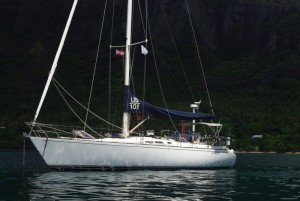
Who: Bruce and Laura Masterson
Port: St. John, USVI
